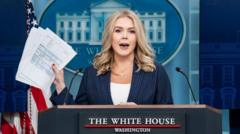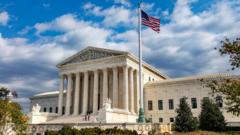In a significant ruling, a US district judge has directed the Trump administration to restore the Associated Press's (AP) access to presidential events after it was barred over the agency’s refusal to adopt “Gulf of America,” the new name for the Gulf of Mexico as designated by the administration. District Judge Trevor McFadden stated that the restrictions imposed on AP journalists were inconsistent with the First Amendment’s guarantees of freedom of speech and press.
US Court Reinforces Press Freedom: AP's Access Restored After Controversial Dispute

US Court Reinforces Press Freedom: AP's Access Restored After Controversial Dispute
A US judge mandates the reinstatement of the Associated Press's access to the White House, citing First Amendment rights following a naming dispute.
The conflict arose when the White House mandated a renaming of the Gulf, reflecting a position by then-President Donald Trump, which the AP opposed by continuing to use the traditional name, “Gulf of Mexico”. The blockade meant AP journalists could not report from key presidential events, including those held in the Oval Office and aboard Air Force One.
Judge McFadden, notably appointed by Trump, ruled that “if the Government opens its doors to some journalists… it cannot then shut those doors to other journalists because of their viewpoints.” He placed a temporary pause on the implementation of the ruling until Sunday to allow for potential appeals by the administration.
Following the verdict, AP spokesperson Lauren Easton expressed relief, saying it validates the importance of press freedom and robust discourse in America. This ruling was positively received by various free speech organizations, including the Knight First Amendment Institute, which underscored the retaliation seen against AP as unconstitutional.
The AP filed a lawsuit against key Trump administration officials over the restrictions on press access, leading to contentious debate surrounding the naming of the Gulf. While the White House maintained that the AP was not entitled to exclusive access, the ongoing legal saga highlights the tensions between government narratives and the independent stance of media outlets.
Caught in the political fray, the AP remains committed to journalistic integrity, asserting its decision to maintain usage of “Gulf of Mexico” despite the administration’s pressure.
This ruling gets to the heart of legislative implications surrounding press freedoms, illustrating both the complexities of media relations in political scenarios and the necessity for transparency and inclusivity in governmental communication channels.
Judge McFadden, notably appointed by Trump, ruled that “if the Government opens its doors to some journalists… it cannot then shut those doors to other journalists because of their viewpoints.” He placed a temporary pause on the implementation of the ruling until Sunday to allow for potential appeals by the administration.
Following the verdict, AP spokesperson Lauren Easton expressed relief, saying it validates the importance of press freedom and robust discourse in America. This ruling was positively received by various free speech organizations, including the Knight First Amendment Institute, which underscored the retaliation seen against AP as unconstitutional.
The AP filed a lawsuit against key Trump administration officials over the restrictions on press access, leading to contentious debate surrounding the naming of the Gulf. While the White House maintained that the AP was not entitled to exclusive access, the ongoing legal saga highlights the tensions between government narratives and the independent stance of media outlets.
Caught in the political fray, the AP remains committed to journalistic integrity, asserting its decision to maintain usage of “Gulf of Mexico” despite the administration’s pressure.
This ruling gets to the heart of legislative implications surrounding press freedoms, illustrating both the complexities of media relations in political scenarios and the necessity for transparency and inclusivity in governmental communication channels.






















